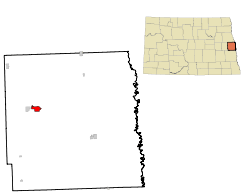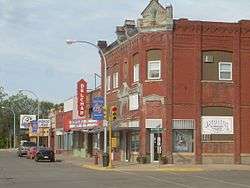Mayville, North Dakota
| Mayville, North Dakota | |
|---|---|
| City | |
|
Downtown Mayville | |
 Location of Mayville, North Dakota | |
| Coordinates: 47°29′59″N 97°19′32″W / 47.49972°N 97.32556°WCoordinates: 47°29′59″N 97°19′32″W / 47.49972°N 97.32556°W | |
| Country | United States |
| State | North Dakota |
| County | Traill |
| Founded | 1881 |
| Area[1] | |
| • Total | 1.92 sq mi (4.97 km2) |
| • Land | 1.92 sq mi (4.97 km2) |
| • Water | 0 sq mi (0 km2) |
| Elevation | 971 ft (296 m) |
| Population (2010)[2] | |
| • Total | 1,858 |
| • Estimate (2016)[3] | 1,830 |
| • Density | 970/sq mi (370/km2) |
| Time zone | Central (CST) (UTC-6) |
| • Summer (DST) | CDT (UTC-5) |
| ZIP code | 58257 |
| Area code(s) | 701 Exchange: 786 |
| FIPS code | 38-51500 |
| GNIS feature ID | 1030125[4] |
| Highways | ND 18, ND 200 |
| Website | http://www.mayvilleportland.com/ |
Mayville is a city in Traill County, North Dakota, United States. The population was 1,858 at the 2010 census,[5] which makes Mayville the largest community in Traill County. Mayville was founded in 1881. The city's name remembers May Arnold, the first white child born in the immediate area.[6]
Mayville is often grouped with the neighboring city of Portland.[7] The two towns are sometimes given the name May-Port. Mayville State University is located in Mayville.
Geography
Mayville is located at 47°29′59″N 97°19′32″W / 47.49972°N 97.32556°W (47.499830, -97.325545).[8]
Mayville sits in the fertile Red River Valley on the banks of the Goose River. The Valley was once a part of glacial Lake Agassiz. As the glacier receded, it left the land very flat, but also very rich. The area around Mayville is prime agricultural land.
According to the United States Census Bureau, the city has a total area of 1.92 square miles (4.97 km2), all of it land.[1]
In the summer of 2006, the community celebrated the city's 125th anniversary.
Demographics
| Historical population | |||
|---|---|---|---|
| Census | Pop. | %± | |
| 1890 | 657 | — | |
| 1900 | 1,106 | 68.3% | |
| 1910 | 1,070 | −3.3% | |
| 1920 | 1,218 | 13.8% | |
| 1930 | 1,199 | −1.6% | |
| 1940 | 1,351 | 12.7% | |
| 1950 | 1,790 | 32.5% | |
| 1960 | 2,168 | 21.1% | |
| 1970 | 2,554 | 17.8% | |
| 1980 | 2,255 | −11.7% | |
| 1990 | 2,092 | −7.2% | |
| 2000 | 1,953 | −6.6% | |
| 2010 | 1,858 | −4.9% | |
| Est. 2016 | 1,830 | [3] | −1.5% |
| U.S. Decennial Census[9] 2015 Estimate[10] | |||
2010 census
As of the census[2] of 2010, there were 1,858 people, 773 households, and 384 families residing in the city. The population density was 967.7 inhabitants per square mile (373.6/km2). There were 872 housing units at an average density of 454.2 per square mile (175.4/km2). The racial makeup of the city was 94.2% White, 1.8% African American, 0.6% Native American, 0.2% Asian, 0.1% Pacific Islander, 0.9% from other races, and 2.2% from two or more races. Hispanic or Latino of any race were 2.0% of the population.
There were 773 households of which 19.3% had children under the age of 18 living with them, 41.4% were married couples living together, 6.1% had a female householder with no husband present, 2.2% had a male householder with no wife present, and 50.3% were non-families. 39.2% of all households were made up of individuals and 17.8% had someone living alone who was 65 years of age or older. The average household size was 2.03 and the average family size was 2.74.
The median age in the city was 37.9 years. 15.3% of residents were under the age of 18; 23.2% were between the ages of 18 and 24; 17% were from 25 to 44; 22.1% were from 45 to 64; and 22.4% were 65 years of age or older. The gender makeup of the city was 48.8% male and 51.2% female.
2000 census
As of the census of 2000, there were 1,953 people, 752 households, and 417 families residing in the city. The population density was 1,216.7 people per square mile (468.4/km²). There were 876 housing units at an average density of 545.7/sq mi (210.1/km²). The racial makeup of the city was 97.49% White, 0.26% African American, 1.48% Native American, 0.26% Asian, 0.05% Pacific Islander, 0.31% from other races, and 0.15% from two or more races. Hispanic or Latino of any race were 0.46% of the population.
There were 752 households out of which 23.8% had children under the age of 18 living with them, 46.1% were married couples living together, 6.6% had a female householder with no husband present, and 44.5% were non-families. 35.0% of all households were made up of individuals and 18.1% had someone living alone who was 65 years of age or older. The average household size was 2.16 and the average family size was 2.82.
In the city, the population was spread out with 17.8% under the age of 18, 23.5% from 18 to 24, 18.3% from 25 to 44, 17.2% from 45 to 64, and 23.3% who were 65 years of age or older. The median age was 36 years. For every 100 females there were 93.2 males. For every 100 females age 18 and over, there were 89.5 males.
The median income for a household in the city was $34,635, and the median income for a family was $44,931. Males had a median income of $34,107 versus $21,615 for females. The per capita income for the city was $17,079. About 6.2% of families and 13.4% of the population were below the poverty line, including 12.4% of those under age 18 and 6.2% of those age 65 or over.
Transportation
Airport
The Mayville Municipal Airport is a city owned, public-use airport located one nautical mile (2 km) south of Mayville's central business district.
Education
Mayville is the home of Mayville State University.
Mayville is served by the May-Port CG Public Schools system. "May-Port CG" stands for "Mayville-Portland-Clifford-Galesburg." This system operates Peter Boe Jr. Elementary School, May-Port CG Middle School, and May-Port CG High School.
High school championships
- State Class 'B' boys basketball: 1944, 1946, 1972, 1987, 1996, 1997, 2002, 2003
- State Class 'B' girls basketball: 1975
- State Class 'B' football: 1977, 1984
- State Class 'B' volleyball: 1999, 2001, Winter 2002
- State Class 'B' baseball: 2015
Recreation
Mayville offers several parks with the largest being Island Park. The MayPort Community Center opened in 2000 and offers space for hockey games and other community events. The Mayville Water Park opened in 2002 and features one of the larger water slides in the area. Mayville is also home to the 9-hole Mayville Golf Club.
Media
The Traill County Tribune
Radio
Mayville radio stations:
FM radio:
AM radio:
Notable people
- Clarence Norman Brunsdale (1891 to 1978), U.S. Senator, 24th Governor of North Dakota
- Gulbrand Hagen (1864 to 1919), newspaper editor and publisher
- Ben Jacobson, men's basketball head coach at the University of Northern Iowa
- Dean Knudson, Wisconsin politician
- Jim LeClair, NFL Pro Bowl linebacker, Mayville State University football coach, mayor of Mayville
- Lute Olson, former University of Arizona coach in College Basketball Hall of Fame
Climate
This climatic region is typified by large seasonal temperature differences, with warm to hot (and often humid) summers and cold (sometimes severely cold) winters. According to the Köppen Climate Classification system, Mayville has a humid continental climate, abbreviated "Dfb" on climate maps.[11]
References
- 1 2 "US Gazetteer files 2010". United States Census Bureau. Archived from the original on January 24, 2012. Retrieved 2012-06-14.
- 1 2 "American FactFinder". United States Census Bureau. Retrieved 2012-06-14.
- 1 2 "Population and Housing Unit Estimates". Retrieved June 9, 2017.
- ↑ "US Board on Geographic Names". United States Geological Survey. 2007-10-25. Retrieved 2008-01-31.
- ↑ "2010 Census Redistricting Data (Public Law 94-171) Summary File". American FactFinder. United States Census Bureau. Archived from the original on July 21, 2011. Retrieved 2 May 2011.
- ↑ Federal Writers' Project (1938). North Dakota, a Guide to the Northern Prairie State. WPA. p. 200. ISBN 978-1-62376-033-5.
- ↑ "Welcome to Mayville-Portland, North Dakota!". Mayville-Portland. Retrieved 13 June 2014.
- ↑ "US Gazetteer files: 2010, 2000, and 1990". United States Census Bureau. 2011-02-12. Retrieved 2011-04-23.
- ↑ "U.S. Decennial Census". Census.gov. Archived from the original on May 12, 2015. Retrieved May 29, 2013.
- ↑ "Population Estimates". United States Census Bureau. Retrieved June 3, 2016.
- ↑ Climate Summary for Mayville, North Dakota
External links
- Mayville-Portland official website
- Mayville State University website
- MPCG (Mayville-Portland-Clifford-Galesburg) Public Schools website
- Mayville diamond 75th jubilee (1956) from the Digital Horizons website
- A saga of two cities, 1881-1981 : a history of Mayville-Portland and the area of the May-Port School District of Traill and Steele Counties, N. Dakota from the Digital Horizons website

